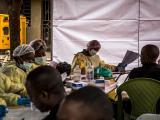May 26, 2011
German lab finds E coli outbreak strain in Spanish cucumbers
Lab tests have linked cucumbers imported from Spain to a enterohemorrhagic Escherichia coli (EHEC) outbreak in Germany that has included an unusually high number of patients with hemolytic uremic syndrome (HUS), Reuters reported today. Cornelia Preufer-Storcks, Hamburg's health minister, told the news service that tests at the Hamburg Institute for Hygiene and the Environment found contamination on four cucumbers, three of which were from Spain. The source of the fourth cucumber hasn't been identified yet. Preliminary results from a case-control study conducted by Germany's Robert Koch Institute suggested contaminated lettuce, tomatoes, or cucumbers could be the source of the outbreak, Deutsche Welle, a German broadcast news service, reported today. Since mid May health officials have received reports of 140 cases of HUS, a potentially fatal kidney complication of E coli infections, Reuters reported, and the outbreak has now been linked to four deaths. In other developments, Swedish officials said they have received many reports of EHEC infections, including 10 patients with HUS, The Local, an English-language news outlet, reported today. As in the German outbreak, the illnesses in Sweden are striking adults rather than children. Preliminary tests show that the outbreak strain is probably the same one responsible for the German outbreak.
May 26 Reuters story
May 26 Deutsche Welle story
May 26 The Local story
CDC confirms first Jamestown Canyon virus infection in Montana
Federal officials today confirmed the first human illness from the Jamestown Canyon virus (JCV), a mosquito-borne arbovirus, in Montana. Writing in Morbidity and Mortality Weekly Report (MMWR), scientists from the Centers for Disease Control and Prevention (CDC) say that a 51-year-old who had not traveled outside of Montana went to a local emergency department May 26, 2009, immediately following onset of fever, severe frontal headache, dizziness, left-sided numbness, hypertension, and tingling. After heart and brain tests were normal, physicians prescribed an antihypertensive drug and sent him home. A week later, however, he visited his primary care physician and described fever, a persistent headache, and new onset of muscle pain and weakness. The primary care physician suspected a stroke or, after learning of the man's contact with mosquitoes, an arbovirus infection. A later neurologic consultation ruled out stroke. Tests at the Montana Public Health Laboratory detected West Nile virus antibodies, but testing at the CDC strongly suggested they were caused by an older infection. Further testing confirmed JCV infection. The man's case is only the 15th JCV infection in the United States since 2004, according to the report.
May 27 MMWR report
Following Ebola case, CDC advises caution for travelers to Uganda
The CDC yesterday issued an alert for US citizens traveling to Uganda because of the Ebola outbreak there that killed a girl on May 6. Saying that Ebola is rare but serious and that the risk is "extremely low," the agency advised travelers to be aware of the disease and take precautions, such as avoiding blood or body fluids from severely ill people and avoiding eating meat from wild animals. The CDC said those working in healthcare settings should employ infection-control practices, including contact and droplet precautions and eye protection.
May 25 CDC alert

















